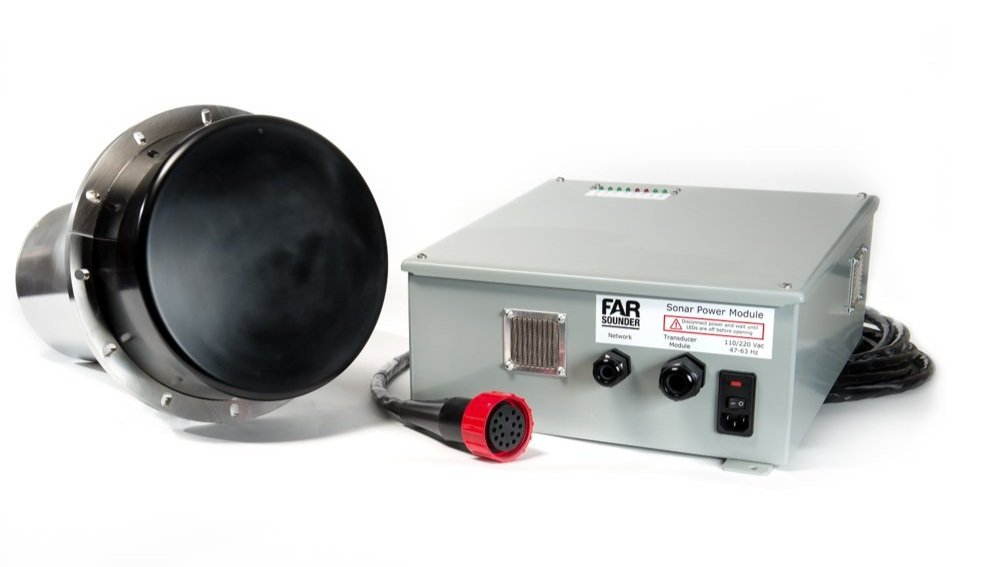Practical Installation Requirements: No Need for Sonar Domes
FarSounder sonar properly installed aboard MY Numptia
Last year we discussed issues to consider when installing FarSounder sonars on a high speed vessel. In that post, we examined various hydrodynamic effects as well as practical considerations when evaluating sonar domes. Sonar domes are often used to reduce the drag of large, low frequency military sonars. In short, sonar domes are expensive and complicated. Fortunately, with a well designed installation, FarSounder sonars have no need for a sonar dome. This blog posting summarizes why domes are sometimes used with other sonar technologies and why our products don’t require them.
Streamlined Flow (Hydrodynamics)
Traditional multibeam sonar with "T" shaped arrays
The Transducer Modules used in FarSounder’s sonars are compact with a small cross-sectional area. When properly installed in a fairing, the installation footprint has a very small effect on the vessel’s hydrodynamics. In fact, many of our customers are refits. None have reported any measurable difference in performance or fuel consumption after installing our sonar.
Some other types of sonar utilize a pair of transducers installed such that one is vertical and the other is horizontal in a “T” or “L” shaped configuration. These shapes are not easily integrated into a hull without a very large cross-sectional area. Their impact to the hull shape can be quite large and a dome may be desired to reduce their impact on the hull shape. If the dome is a “generic” shape and not designed specifically for a particular hull, the dome’s shape may be a poor fit for a particular hull design. Whereas, the unique design of FarSounder’s forward looking navigation sonar negates such a need.
Anchor Chain Protection
Anchor chain along the bow
One concern relating to installing a sensor on the bow is protecting the sensor from the anchor chain. Though no-one ever plans to have the anchor chain pull across the bow, its does happen. When properly installed in its fairing, the array face of a FarSounder Transducer Module is slightly recessed. If the anchor chain does sweep across the bow, the fairing is there to protect the Transducer Module. The fairing can also protect the Transducer Module against impact from debris or even collision with the bumper of a pier.
When using a sonar dome, the dome must be strong enough to protect the arrays from impact damage. It is quite difficult to make a dome strong without making the material very thick. At the high frequency ranges of forward looking navigation sonar, the thickness of the dome material has a notable impact on the sonar’s sensitivity. So, using a dome for anchor chain protection ends up being more expensive and less robust than a simple faring.
Array Calibration
In any sonar array consisting of many receiver elements, a small amount of element to element variation is expected. All of FarSounder’s sonars are calibrated at FarSounder’s acoustic test tank before shipping to a customer. This calibration measures the variation in sensitivity and phase between all of the receive array’s transducer elements.
If a dome is installed over a transducer array, the dome material can cause lensing as well as unwanted structural reverb effects. Lensing effects can be measured with a precise calibration process. However, this requires the array with the dome in place to be calibrated in an acoustic test tank. Calibration with a dome in place is difficult and costly to perform. Unwanted structural reverb cannot be removed with calibration. It can only be measured and added to the system’s noise floor.
Maintenance
An old putty knife
Like any other sonar system, the array face on a FarSounder Transducer Module can become fouled with marine growth. A diver can quickly scrape off fouling from an array face using a standard plastic / wooden putty knife without risking damage to the array’s urethane.
Read more about FarSounder’s recommendations to keep your sonar clean.
Fouling on a sonar dome is similar to fouling on an array face. However, since the volume between the inside of the dome and the internal sonar must be flooded, fouling can occur on both the outside and the inside of the dome. Cleaning the dome becomes a complicated procedure since the diver must access both sides of the dome. In an effort to minimize fouling on the inside of the dome, this volume is sometimes sealed from the ambient sea water and filled with another fluid. In this case, how is this filled? If the sonar needs to be serviced, how can it be removed by a diver? Usually, such an installation requires drydocking the vessel in order to access the sonar.
Conclusion
FarSounder’s sonars are designed to be installed “as is” in a simple fairing. Our fairing design provides for a robust, low cost installation solution which is easy to maintain. A full installation design guide and example installation drawings are available upon request.








